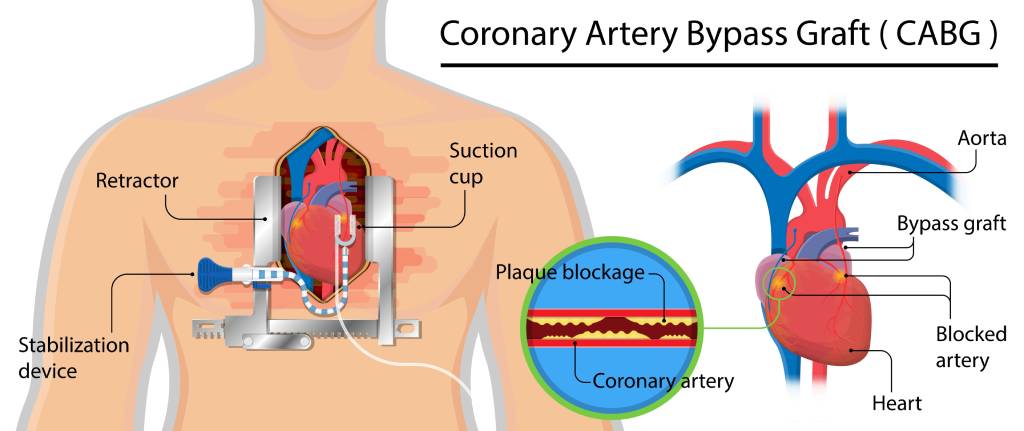Coronary Artery Bypass Grafting (CABG): A Life-Saving Procedure
Coronary Artery Bypass Grafting (CABG), often referred to as heart bypass surgery, is one of the most advanced and commonly performed procedures to treat coronary artery disease (CAD). CAD occurs when the blood vessels that supply oxygen and nutrients to the heart become blocked or narrowed, primarily due to plaque buildup, leading to reduced blood flow. If left untreated, it can result in chest pain (angina), heart failure, or even a heart attack.
CABG surgery is designed to restore normal blood flow to the heart by rerouting blood through healthy blood vessels, ensuring the heart receives adequate oxygen for its functioning. With advancements in medical technology and surgical techniques, CABG has become a trusted solution for millions of people worldwide.
Understanding Coronary Artery Bypass Grafting
CABG involves using a healthy blood vessel, referred to as a graft, to bypass the blocked artery. This graft is often taken from the patient’s own body, such as the saphenous vein from the leg, the internal mammary artery from the chest, or the radial artery from the arm. By creating an alternative pathway, the graft ensures uninterrupted blood flow to the heart.
CABG is particularly beneficial for patients who have:
- Multiple Blockages: When multiple coronary arteries are severely blocked, CABG offers the best chance of improving blood flow.
- Left Main Coronary Artery Disease: This condition, which affects the primary artery supplying blood to the heart, often requires bypass surgery.
- Failed Angioplasty or Stent Placement: CABG is an alternative for patients whose previous treatments, like angioplasty or stent insertion, have been unsuccessful.
Types of CABG Procedures
- Traditional CABG (Open-Heart Surgery):
This is the most common form of CABG, where the surgeon makes a large incision in the chest and temporarily stops the heart to perform the surgery using a heart-lung machine.
- Off-Pump CABG:
Also known as beating-heart surgery, this method does not require stopping the heart. The surgeon performs the procedure on a beating heart with specialized tools to stabilize the area being operated on.
- Minimally Invasive CABG:
This advanced approach involves smaller incisions and is suitable for certain patients with less severe blockages. It offers faster recovery and reduced postoperative pain.
- Robotic-Assisted CABG:
With cutting-edge technology, surgeons use robotic arms to perform CABG with extreme precision, enhancing safety and efficiency.
Benefits of Coronary Artery Bypass Grafting
CABG offers a range of life-changing benefits, including:
- Improved Heart Function: By restoring blood flow, CABG helps the heart pump more effectively, reducing strain and fatigue.
- Symptom Relief: Patients experience significant relief from angina (chest pain) and shortness of breath.
- Better Quality of Life: With reduced symptoms, patients can resume normal activities, enjoy improved energy levels, and live healthier lives.
- Long-Term Survival: CABG reduces the risk of future heart attacks and improves long-term survival rates for patients with advanced coronary artery disease.
- Minimized Hospital Visits: The procedure reduces the likelihood of emergency hospitalizations for heart-related issues.
Preparing for CABG
Proper preparation is crucial for a successful outcome. Patients typically undergo a thorough evaluation, including:
- Diagnostic Tests: These may include an electrocardiogram (ECG), echocardiogram, chest X-rays, angiograms, and blood tests to assess heart function and identify blockages.
- Lifestyle Adjustments: Quitting smoking, managing weight, and controlling conditions like diabetes or hypertension are essential before surgery.
- Medication Management: Patients may be advised to stop taking certain medications, such as blood thinners, to minimize surgical risks.
The CABG Procedure: Step by Step
Anesthesia and Incision:
The patient is placed under general anesthesia. For traditional CABG, the surgeon makes an incision along the chest to access the heart.
Harvesting the Graft:
A healthy blood vessel is harvested from another part of the patient’s body, such as the leg, arm, or chest, to be used for the bypass procedure.
- Bypassing the Blocked Artery:
The surgeon attaches the graft to bypass the blockage, creating a new pathway for blood flow.
- Completing the Surgery:
The heart is restarted (if stopped), and the chest is closed with sutures or staples.
The surgery typically lasts 3-6 hours, depending on the complexity of the case.
Recovery After CABG
The recovery period for CABG varies from patient to patient. Here’s what to expect:
- Hospital Stay: Patients usually spend 5-7 days in the hospital, with the first 1-2 days in the intensive care unit (ICU) for close monitoring.
- Physical Recovery: Full recovery takes about 6-12 weeks. Patients are encouraged to gradually increase physical activity, starting with short walks.
- Cardiac Rehabilitation: Many patients participate in a cardiac rehab program, which includes supervised exercise and guidance on adopting a heart-healthy lifestyle.
- Lifestyle Changes: Quitting smoking, eating a balanced diet, exercising regularly, and managing stress are essential for maintaining the benefits of CABG.
Why Choose India for CABG?
India has emerged as a global leader in providing high-quality cardiac care. Here’s why patients from around the world choose India for CABG:
- Expertise of Surgeons: India is home to internationally renowned heart surgeons specializing in minimally invasive CABG and complex cardiac procedures.
- Affordable Treatment Costs: The cost of CABG in India is a fraction of what it costs in Western countries, making it an ideal destination for cost-effective treatment.
- State-of-the-Art Hospitals: Indian hospitals are equipped with advanced technology, offering comprehensive cardiac care, including diagnostics, surgery, and rehabilitation.
- Holistic Medical Tourism Services: International patients benefit from seamless services, including visa assistance, airport transfers, accommodation, and post-operative care.
CABG with Healtour Solutions
Healtour Solutions connects patients with India’s top hospitals and expert cardiac surgeons for world-class CABG surgery. We offer:
- Access to Leading Hospitals: Partnering with India’s best cardiac care centers, we ensure access to cutting-edge facilities and technology.
- Customized Packages: Our affordable treatment plans include surgery, hospital stay, rehabilitation, and travel assistance.
- Personalized Support: Our dedicated team guides patients at every step, from pre-surgery consultations to post-surgery recovery.
- Global Reach: We serve patients from around the world, offering multilingual support and culturally sensitive care.
The Role of Lifestyle Changes Post-CABG
CABG is a life-saving surgery, but maintaining its benefits requires adopting a healthy lifestyle. Here are some key changes patients should make:
- Balanced Diet: Focus on a diet rich in fruits, vegetables, whole grains, and lean proteins while avoiding saturated fats, sugars, and excess salt.
- Regular Exercise: Engage in moderate physical activity like walking, swimming, or yoga to strengthen the heart.
- Stress Management: Practice stress-reducing techniques such as meditation, deep breathing, or hobbies to promote mental well-being.
- Routine Checkups: Regular follow-ups with a cardiologist ensure timely monitoring of heart health and early detection of any issues.
Book Your CABG Consultation Today!
Don’t let coronary artery disease compromise your health. Contact Healtour Solutions today to connect with the best cardiac surgeons in India and regain your health with affordable CABG surgery in India.
FAQs About Coronary Artery Bypass Grafting (CABG)
What is CABG?
CABG, or Coronary Artery Bypass Grafting, is a surgical procedure that reroutes blood around blocked coronary arteries using healthy blood vessels from other parts of the body. This improves blood flow to the heart and restores its proper function.
How do I know if I need CABG?
CABG is recommended for severe coronary artery disease, multiple blockages, or when angioplasty isn’t viable.
Is CABG a safe procedure?
Yes, CABG is a common and safe procedure with high success rates, especially in top cardiac hospitals in India.
How long does the CABG procedure take?
The procedure typically takes 3-6 hours, depending on the number of grafts needed.
What is the recovery time for CABG?
Most patients recover within 6-12 weeks, with proper care and a healthy lifestyle post-surgery.
Will I feel pain during or after CABG?
You’ll be under general anesthesia during the surgery, so you won’t feel pain. Post-operative discomfort is managed with medications.
How long do bypass grafts last?
Bypass grafts can last for 10-15 years or longer with good medical care and a heart-healthy lifestyle.
What are the risks of CABG?
Risks include infection, bleeding, or blood clots, but these are rare when the procedure is performed by experienced heart surgeons in India.
How much does CABG cost in India?
The cost of heart bypass surgery in India ranges from $5,000 to $8,000 USD, making it a cost-effective option compared to Western countries.
Why choose India for CABG?
India offers expert care, advanced medical facilities, and cost-effective treatment options for cardiac bypass surgeries, making it an ideal choice for international patients.




